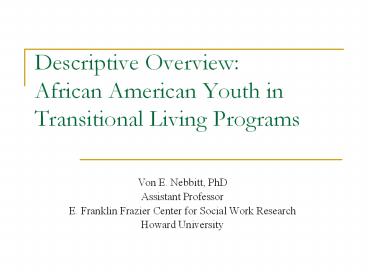Descriptive Overview: African American Youth in Transitional Living Programs - PowerPoint PPT Presentation
1 / 23
Title:
Descriptive Overview: African American Youth in Transitional Living Programs
Description:
African American youth are also over-represented among runaway/homeless youth in ... annual incidence of runaway / homelessness among African American youth ... – PowerPoint PPT presentation
Number of Views:100
Avg rating:3.0/5.0
Title: Descriptive Overview: African American Youth in Transitional Living Programs
1
Descriptive OverviewAfrican American Youth in
Transitional Living Programs
- Von E. Nebbitt, PhD
- Assistant Professor
- E. Franklin Frazier Center for Social Work
Research - Howard University
2
Introduction
- African American youth are one of our nations
most vulnerable populations - They are
- Over-represented in Juvenile Justice System
- Under-served by mental health community
- Failed by public education
- Second lease likely to be insured
- Most likely to live in impoverish urban areas
3
Introduction
- African American youth are also over-represented
among runaway/homeless youth in urban areas - Being homeless probably increases their
vulnerabilities exponentially - It is likely that runaway/homeless AA youth are
more susceptible to gangs and involvement in
alternative market activities to wit,
prostitution drugs - BUT WE DONT KNOW THIS FOR SURE!
4
Introduction
- The current state of Runaway/Homeless African
American youth is ambiguous at best and totally
unknown at worse - A thorough portrayal of this population is not
readily available in the empirical literature - Therefore, a definitive statement about their
physical, mental, academic and emotional status
is not possible - A logical first step in this area of research is
to began to pull together the pieces of this
puzzle
5
Purpose
- The purpose of this presentation is to provide a
descriptive overview of African American youth in
transitional living programs
6
Data Source
- Family Youth Service Bureaus (FYSB)
- Transitional Living Program (TLP)
- FY 2002 FY2006
- Transitional Living Program
- Provide homeless youth ages 16 to 21 with
stable, safe longer-term residential services up
to 18 months (or longer if the youth has not
reached age 18)
7
Population Characteristics
- Original data set includes 20391
- Includes five waves 2002 to 2006
- 33 (6617) African American
- 57 (11636) female
- 78 (16242) heterosexual
8
Subsample Criterion
- African American youth
- Complete data (i.e. entry, service and exit data)
for all years - No repeat data (Only one visit for this youth
within this data) - Resulted in subsample of 4263
9
What did we find?
10
Demographic Characteristics
Data on age (date of birth) and sexual
orientation did not convert to SPSS
11
Living Situation at Entry
12
Referral Source
13
Employment Status at Entry
14
Percent in Foster Care
Youth in Foster Care Spent on Average 3.75 years
in care
15
Percent in Juvenile Justice Involved
Youth in Juvenile Justice System Spent on Average
4 years in system
16
School Status
17
Highest Grade Completed
18
Teen Parenthood
19
Limitations to this exploration
- Some important indices lost in conversion
- High number of missing observation on foster care
and juvenile justice involvement - Wasnt able to disaggregate to examine annual
trends - Many indices are grouped (i.e., highest grade
completed 9 12)
20
What do we know from TLP data?
- Twice as many females use TLP
- Most in TLP youth come from private residents
- Very few of the youth have children
- Most are in school of have graduated or have GEDs
21
What dont we know from TLP data?
- Actual scope of the population or the problem
- Rate of runaway/homeless service use for African
American youth - Individual, familial community antecedence to
runaway/homeless episodes - Factors that contribute to stable residency or
independent living following an episode
22
Next Steps
- Identify existing runaway/homeless youth data
sets that included African American youth to
attempt to understand the breadth and the scope
of the problem - Prevalence and annual incidence of runaway /
homelessness among African American youth - Set-up runaway / homeless surveillance systems in
urban areas where African American youth are
likely to hang-out (i.e., housing projects)
23
Thank You
- Any Questions?































